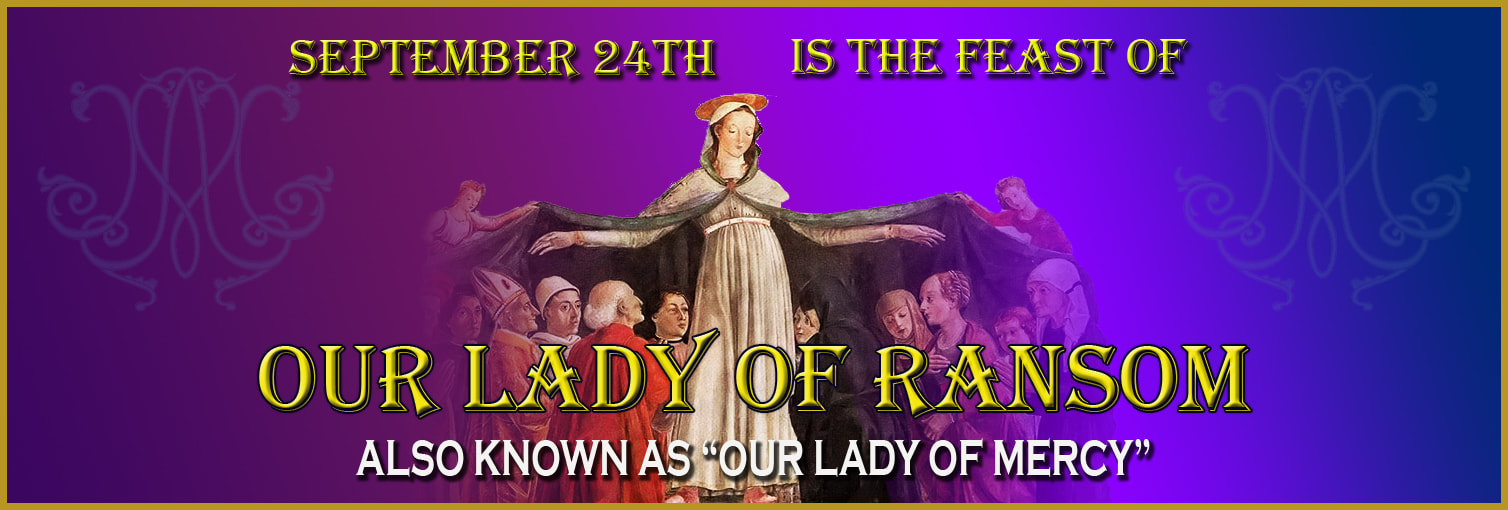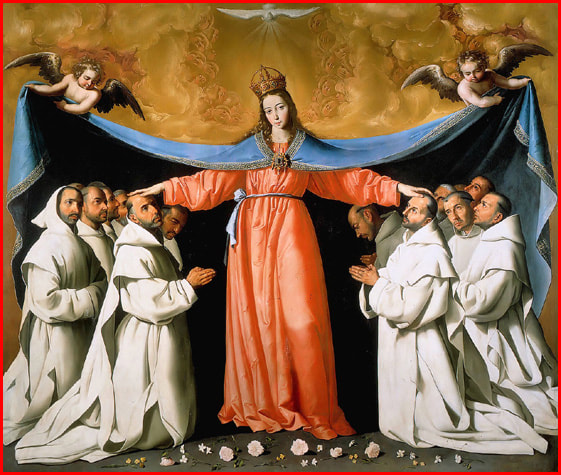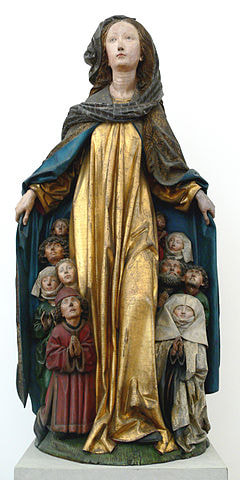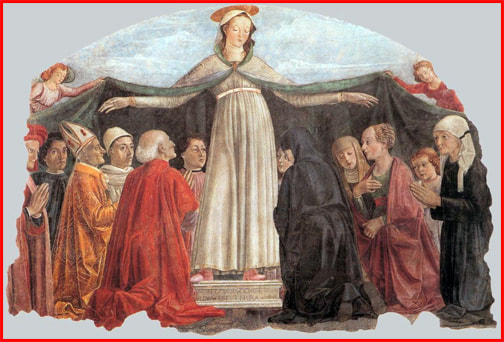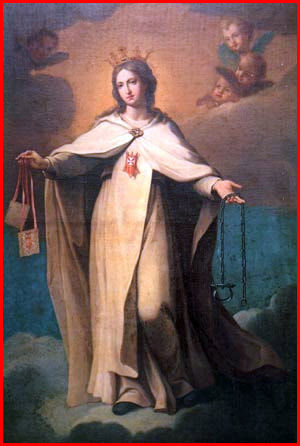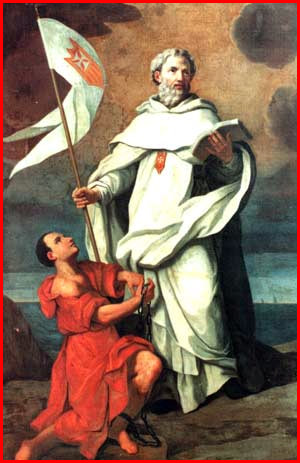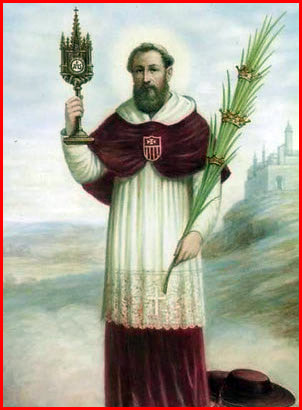| Devotion to Our Lady |
|
- Homepage
-
Daily Thoughts
- 2023 October Daily Thoughts
- Daily Thoughts Lent 2020
- Daily Thoughts for Advent 2019
- Daily Thoughts for October 2019
- Daily Thoughts for September 2019
- Daily Thoughts for August 2019
- Daily Thoughts for July
- Daily Thoughts for June
- Daily Thoughts for Easter 2019
- Daily Thoughts for Lent 2019
- Daily Thoughts for Christmas
- Daily Thoughts Easter 2022
- Sacred Heart
- Consecration
-
Spiritual Life
- Holy Mass Explained
- First Friday Devotions
- First Saturday Devotions
- The Mercy of God
- Vocations
- The Path Everyone Must Walk >
- Gift of Failure
- Halloween or Hell-O-Ween?
- Ignatian Spiritual Exercises >
- Meditation is Soul-Saving
- Spiritual Communion
- Miraculous Medal
- Enrollment in Miraculous Medal
- St. Benedict Medal
- Holy Water
- Advice on Prayer
- Your Daily Mary
-
Prayers
- September Devotions
- Seven Sorrows of Our Lady
-
Novenas
>
- NV-Help of Christians
- NV-Nativity of Our Lady
- NV-Seven Sorrows
- NV- Sorrowful Heart
- NV-Pope St Pius X
- NV-La Salette
- NV-St Michael Archangel
- NV-Immaculate Heart
- NV-Assumption
- NV-Novena for Fathers
- NV-Novena for Your Mother
- NV-St Raphael Archangel
- NV-Souls in Purgatory
- NV-All Saints Day
- NV-Christ the King
- NV-Divine Motherhood
- NV-Guardian Angels
- NV-Rosary
- NV-Mirac Med
- NV- Imm Conc
- NV - Guadalupe
- NV - Nativity of Jesus
- NV-Epiphany
- NV-OL Good Success
- NV-Lourdes
- NV-St Patrick
- NV-St Joseph
- NV-Annunciation
- NV-St Louis de Montfort
- NV-OL Good Counsel
- NV-Last Supper
- NV-Passion
- NV-Pentecost
- NV-Ascension
- NV-Sacred Heart
- NV-Sacred Heart & Perpetual Help
- NV-Corpus Christi
- NV-OL of Perpetual Help
- NV-Queenship BVM
- NV-OL of Mount Carmel
- NV-St Mary Magdalen
- NV- Im Hrt
- August Devotions to IHM
- Immaculate Heart of Mary
- Litany of Dependence
- Prayers to St Mary Magdalen
- Prayers in Times of Sickness Disease & Danger
- Holy Souls in Purgatory
- Meditations on the Litany of Our Lady
- Special Feast Days
- Prayers to Mary (Mon-Sun)
- Litanies to Our Lady >
- Various & Special Needs
- Our Lady of the Rosary
- Our Lady of Mt. Carmel
- Our Lady of Perpetual Help
- Our Lady of Guadalupe
- Other titles of Our Lady
-
Rosary
- Downloads
- Easter Season
-
Holy Week
- Last Seven Words of Jesus >
- Characters of Passion >
- The Last Days of Christ
- Before Palm Sunday
- Palm Sunday
- Monday in Holy Week
- Tuesday in Holy Week
- Wednesday in Holy Week
- Holy Thursday (Last Supper)
- Holy Thursday (Agony & Arrest)
- Night Vigil with Christ
- Good Friday (Pilate & Herod)
- Good Friday (Way of Cross & Crucifixion)
- Saturday in Holy Week
-
Lent
- Ideas for Lent
- Daily Lenten Planner
- Daily Lenten Liturgy
- From Cold to Hot
- Lent with Aquinas
- Lent with Dom Gueranger
- Virtues for Lent
- History of Penance
- How Expensive is Sin?
- Confession of Sins
- Letter to Friends of the Cross
- Sermons for Lent
- Stations of the Cross >
- Lenten Prayers
- 7 Penitential Psalms
- Lenten Psalms SUN
- Lenten Psalms MON
- Lenten Psalms TUE
- Lenten Psalms WED
- Lenten Psalms THU
- Lenten Psalms FRI
- Lenten Psalms SAT
- Lenten Laughs
- Septuagesima
-
Christmas
- Epiphany Explained
- Suggestions for Christmas
- Food For Thought
- Christmas with Aquinas
- Christmas with Dom Gueranger
- Christmas Prayers
- Candles & Candlemas
- Christmas Sermons
- Christmas Prayers SUN
- Christmas Prayers MON
- Christmas Prayers TUE
- Christmas Prayers WED
- Christmas Prayers THU
- Christmas Prayers FRI
- Christmas Prayers SAT
- Twelve Days of Christmas >
-
Advent Journey
- Purgatory
- Christ the King
- Legion of Mary
- Scapular
-
Saints
-
Martyrs for the Faith
>
- Your Daily Martyr >
- All 365 Days of Martyrs
- Cristeros
- St Valentine & Valentine's Day
- Martyrs--Thomas Becket
- Martyrs--John the Apostle
- Holy Machabees
- Age of Martyrdom
- Carmelites of Compiegne
- Martyrs--Peter & Paul
- Martyrs--John the Baptist
- Martyrs--Andrew
- Martyrs--James the Great
- Martyrs--North American
- Martyrs--Seven Holy Sleepers
- Martyrs--Afra
- School of Martyrdom
- Martyrs--Christina
- Desert Saints >
- Saints for Sinners >
- Saints of Mary >
- History of All Saints Day
-
Martyrs for the Faith
>
- Precious Blood
- Holy Ghost
- Synod 2023
-
Catechism
- Catechism Lesson 1
- Catechism Lesson 2
- Catechism Lesson 3
- Catechism Lesson 4
- Catechism Lesson 5
- Catechism Lesson 6
- Catechism Lesson 7
- Catechism Lesson 8
- Catechism Lesson 9
- Catechism Lesson 10
- Catechism Lesson 11
- Catechism Lesson 12
- Catechism Lesson 13
- Catechism Lesson 14
- Catechism Lesson 15
- Catechism Lesson 16
- Catechism Lesson 17
- Catechism Lesson 18
- Catechism Lesson 19
- Catechism Lesson 20
- Catechism Lesson 21
- Catechism Lesson 22
- Bible Study
-
Calendar
- Miracles
- Apparitions
- Shrines
- Prophecies
- Angels Homepage
- Hell
-
Church Crisis
- Conspiracy Theories
- Amazon Synod 2019 >
- Liberalism & Modernism
- Modernism--Encyclical Pascendi
- Modernism & Children
- Modernism--Documents
- The Francis Pages
- Church Enemies on Francis
- Francis Quotes
- Amoris Laetitia Critique
- Danger of Ignorance (Pius X)
- Restore all In Christ (Pius X)
- Catholic Action (Pius X)
- Another TITANIC Disaster?
- The "Errors of Russia"
- CRISIS PRAYERS
- Election Novena 2024
- The Anger Room
- War Zone
- Life of Mary
- Spiritual Gym
- Stupidity
- Coronavirus and Catholicism
- History & Facts
- Books
- Catholic Family
- Children
- Daily Quiz
-
Novena Church & Pope
- Day 01 Church-Pope Novena
- Day 02 Church-Pope Novena
- Day 03 Church-Pope Novena
- Day 04 Church-Pope Novena
- Day 05 Church-Pope Novena
- Day 06 Church-Pope Novena
- Day 07 Church-Pope Novena
- Day 08 Church-Pope Novena
- Day 09 Church-Pope Novena
- Day 10 Church-Pope Novena
- Day 11 Church-Pope Novena
- Day 12 Church-Pope Novena
- Day 13 Church-Pope Novena
- Day 14 Church-Pope Novena
- Day 15 Church-Pope Novena
- Day 16 Church-Pope Novena
- Day 17 Church-Pope Novena
- Day 18 Church-Pope Novena
- Day 19 Church-Pope Novena
- Day 20 Church-Pope Novena
- Day 21 Church-Pope Novena
- Day 22 Church-Pope Novena
- Day 23 Church-Pope Novena
- Day 24 Church-Pope Novena
- Day 25 Church-Pope Novena
- Day 26 Church-Pope Novena
- Day 27 Church-Pope Novena
- Day 28 Church-Pope Novena
- Day 29 Church-Pope Novena
- Day 30 Church-Pope Novena
- Day 31 Church-Pope Novena
- Day 32 Church-Pope Novena
- Day 33 Church-Pope Novena
- Day 34 Church-Pope Novena
- Day 35 Church-Pope Novena
- Day 36 Church-Pope Novena
- Day 37 Church-Pope Novena
- Day 38 Church-Pope Novena
- Day 39 Church-Pope Novena
- Day 40 Church-Pope Novena
- Day 41 Church-Pope Novena
- Day 42 Church-Pope Novena
- Day 43 Church-Pope Novena
- Day 44 Church-Pope Novena
- Day 45 Church-Pope Novena
- Day 46 Church-Pope Novena
- Day 47 Church-Pope Novena
- Day 48 Church-Pope Novena
- Day 49 Church-Pope Novena
- Day 50 Church-Pope Novena
- Day 51 Church-Pope Novena
- Day 52 Church-Pope Novena
- Day 53 Church-Pope Novena
- Day 54 Church-Pope Novena
- Penance Novena
- Daily WeAtheR Forecast
LINKS TO OTHER SPECIAL FEASTS (not all links have been activated at this time)
| Nativity of Mary (Sep 8) | Seven Sorrows of Mary (Sep 15) | Our Lady of Ransom (Sep 24) | Our Lady of the Rosary (Oct 7) | Divine Maternity (Oct 11) |
| Presentation of Mary in Temple (Nov 21) | Our Lady of the Miraculous Medal (Nov 27) | Immaculate Conception (Dec 8) |
| Our Lady of Guadalupe (Dec 12) | Purification of Mary (Feb 2) | Annunciation (Mar 25) | Help of Christians (May 24) |
For the other meditations click on any link below (not all links have been activated at this time)
| 12-MONTH OVERVIEW OF FEAST DAYS | SPECIAL FEASTS OF MARY | JANUARY | FEBRUARY | MARCH |
| APRIL | MAY | JUNE | JULY | AUGUST | SEPTEMBER | OCTOBER | NOVEMBER | DECEMBER |
| Nativity of Mary (Sep 8) | Seven Sorrows of Mary (Sep 15) | Our Lady of Ransom (Sep 24) | Our Lady of the Rosary (Oct 7) | Divine Maternity (Oct 11) |
| Presentation of Mary in Temple (Nov 21) | Our Lady of the Miraculous Medal (Nov 27) | Immaculate Conception (Dec 8) |
| Our Lady of Guadalupe (Dec 12) | Purification of Mary (Feb 2) | Annunciation (Mar 25) | Help of Christians (May 24) |
For the other meditations click on any link below (not all links have been activated at this time)
| 12-MONTH OVERVIEW OF FEAST DAYS | SPECIAL FEASTS OF MARY | JANUARY | FEBRUARY | MARCH |
| APRIL | MAY | JUNE | JULY | AUGUST | SEPTEMBER | OCTOBER | NOVEMBER | DECEMBER |
THE HISTORY BEHIND OUR LADY OF RANSOM OR OUR LADY OF MERCY
|
As Our Lady of Ransom was also known as Nuestra Señora de la Merced (Our Lady of Mercy), later representations mirrored that motif, showing people sheltered for protection under her outspread cloak.
The “Crown of Twelve Stars of Our Lady of Mercy” is an ancient devotion of the Order of Our Lady of Mercy based on the Book of Revelation (12:1): “And a great sign appeared in heaven: a woman clothed with the sun, and the moon under her feet, and on her head a crown of twelve stars.” It is prayed on a chaplet. The chaplet consists in a medal, five Our Father beads and three sets of four beads each where the Hail Mary is prayed in honor of Our Lady’s Crown of Excellence. The chaplet ends with a Glory be.
Sometimes Our Lady of Ransom is depicted holding the scapular of the order.
SAINTS OF THE ORDER OF OUR LADY OF RANSOM
St. Peter Nolasco A merchant and a gentle man, St. Peter Nolasco was holy in a radical sense. With a small group of friends and fellow workers with whom he had been associated for some time, he founded the Order of the B.V.M. of Mercy for the Redemption of Captives in 1218. Because of his liberating activity, he was and remains within the church and for the world, the living image of Jesus surrendering himself to the point of death to save and redeem captives, sinners and the lost of this earth.
Being a merchant, a bourgeois born around 1180, he begins to work hard at the beginning of the 13th century. Differently from Francis of Assisi, Peter does not feel the need to break with all forms of money, wealth and buying and selling in order to reach Christ’s radical poverty. He comes to the same conclusion but in a radically different way: he encounters Jesus in the very heart of his business, he meets him in the captives, in the Christian slaves in Moslem lands. This leads him to the center of the social and religious conflict dividing the known world at the time. Peter was building the lines of a new movement dedicated mostly to the liberation of captives. He was a man of his time, touched to the quick by the problems of his age and responding to them creatively. Jesus’ Gospel began in Galilee, but it keeps on being actualized on earth. Nolasco’s good news has its beginning in Barcelona, between the 12th and the 13th centuries, but it lives on with all its value for mankind. St. Raymond Nonnatus
Raymond, universally known as Nonnatus or not born due to his atypical birth, is the Mercedarian saint who achieved the greatest popularity among Christians in the places, kingdoms and nations where Mercedarians became established.
According to the most reliable Mercedarian tradition, Saint Raymond was born in the town of Portello, situated in the Segarra region of the Province of Lérida at the dawn of the thirteenth century. He was given the surname of Nonnatus or not born because he came into the world through an inspired and urgent incision which the Viscount of Cardona made with a dagger in the abdomen of the dead mother. In his adolescence and early youth, Raymond devoted himself to pasturing a flock of sheep in the vicinity of a Romanesque hermitage dedicated to Saint Nicholas where an image of the Virgin Mary was venerated. His devotion to the Holy Mother of Jesus started there. He joined the Order of Mercy at a very early age. Father Francisco Zumel relates that young Raymond was a “student of the watchful first brother and Master of the Order, Peter Nolasco.” Therefore, Raymond was a redeemer of captives in Moorish lands. In a redemption which took place in Algiers, they had to stay behind as hostages. It was then that he endured the torment of having his lips sealed with an iron padlock to prevent him from addressing consoling words to Christian captives and from preaching the liberating good news of the Gospel. After he had been rescued by his Mercedarian brothers, Pope Gregory IX appointed him Cardinal of the Church of San Eustaquio. Summoned by the Supreme Pontiff, Raymond was on his way to Rome when he met death in the strong and rocky castle of Cardona in 1240. The Order of Mercy, the viscount and the city of Cardona were all arguing over his dead body, and where it should be buried, it was entrusted to Divine Providence on the harness of a blind mule. Without anyone leading it, the mule accompanied by a crowd trotted to Saint Nicholas hermitage where the venerable body was buried. St. Peter Paschasius
The son of devout Mozarabs, Peter Paschasius was born in Valencia in 1227. Peter Nolasco and his brothers knew young Peter’s family and they stayed at their house near the Gate of Valldigna when they were on their way to a redemption. Peter Paschasius started his ecclesiastical career in his native city and he completed his studies at the University of Paris. Upon returning to Valencia, he was honored with the post of canon of the cathedral church.
Soon after, he left his post to join the Order of Mercy and he received the habit in the Valencia Cathedral at the hands of Arnaldo of Carcassonne in 1250. He traveled to Rome in 1296 and Pope Boniface VIII appointed him bishop of Jaén. On February 20th, 1296, he was consecrated by Cardinal Mateo de Acquasparta in Saint Bartholomew’s chapel of the island on the Tiber. Later, when he was making a pastoral visit to his Jaén Diocese, he was attacked and taken captive to Granada by the Moors of that kingdom. While in jail, he wrote in Provençal: Dispute of the Bishop of Jaén with the Jews and Refutation of the Mohammedan Sect, two very interesting works with apologetic content to provide Christian captives with arguments against the proselytizing sermons of the Jews and Moslems. Peter also wrote: The Book of Gamaliel dealing with Christ’s passion and death, The Destruction of Jerusalem, Treatise against Moslem Fatalism, The Gloss on the Pater Noster and The Gloss on the Ten Commandments. This learned Mercedarian doctor has the honor of having publicly defended the Immaculate Conception of the Virgin Mary in Paris and in his work, Life of Lazarus, written in 1295, long before any other Western theologian. Several times, his fellow redeemers sent him the ransom money but Peter preferred to have other captives recover their freedom instead of him. The fifty years he had been wearing the Mercedarian habit had left a Mercedarian imprint on his soul. On December 6, 1300, while he was still wearing the vestments he had used to celebrate Mass, he was beheaded in his dungeon. He was buried in the place where the prison was and where he died. Christians called this place, Martyrs’ Hill. Peter’s written works constitute a valuable legacy of the Order of Mercy. Some Mercedarian writers like Manuel Mariano Ribera, 1720, Juan Interián de Ayala, 1721 and Peter Armengol Valenzuela, 1901, have defended the religious status and the Mercedarian profession of this distinguished bishop of Jaén. His works were compiled and published by Fathers Bartolomé de Anento, 1676 and Peter Armengol Valenzuela, 1905-1908. St. Serapion
Irish by birth, Serapion was born around 1179. He enlisted as a soldier in the army of his king, Richard the Lion-Hearted, and later in the company of the Duke of Austria, Leopold VI the Glorious, he enlisted in his squadron to go to Spain to help the Christian army of Alfonso VIII who was fighting Moslems. Once he was in Spain, Serapion decided to stay in the service of the king of Castile to continue fighting to defend the Catholic Faith. There, he had the opportunity to meet Peter Nolasco and his brothers who dedicated themselves to the defense of the same Faith except that they were not fighting against the Moors. Instead, they were freeing Christian captives from the power of the Moors and they pledged their own lives in this endeavor.
In 1222, Serapion requested and received the Mercedarian habit. He carried out several redemptions. In the last one which he carried out with his redeeming companion Berenguer de Bañeres, Serapion had to remain as a hostage for some captives in danger of renouncing their faith. The other redeemer traveled quickly to Barcelona to look for the ransom money. Peter Nolasco, who was in Montpellier at the time, wrote an urgent letter to his lieutenant Guillermo de Bas asking him to notify all the monasteries to collect alms and to send them immediately to Algiers. But the money for the ransom did not arrive at the stipulated time and the disappointed Moors inflicted an atrocious death on Serapion. They nailed him on an X-shaped cross, like Saint Andrew’s cross and they savagely dismembered him. The barbarian and cruel King of Algiers, Selín Benimarin, was the one who gave the Church and the Mercedarian Order this saintly martyr on November 14th, 1240. St. Peter Armengol
Related to the Counts of Urgel, Peter Armengol was born in Guardia dels Prats (Tarragona) in the middle of the thirteenth century. He spent his childhood and adolescence in a quiet family atmosphere of honesty. But having barely reached the threshold of youth, Peter was drawn by bad company to the abyss of dissolute and criminal life of a bandit. In an encounter of armed people sent by James I to rid the area through which the royal suite was to travel of evildoers, with his sword in his hand, libertine Peter Armengol found himself face to face with his own father, Arnaldo. This providential circumstance made Peter lay down his weapons before his progenitor, ask for his pardon and, with iron will, decide to change his life. His father’s prestige saved his son from the deserved punishment and Peter Armengol badgered the Mercedarian friars to accept him in the Order since he wanted to dedicate the rest of his life to the work of mercy of the redemption of captives so that the Lord would use his infinite mercy with him.
After he was received in the Order, Peter was able to go twice to Moorish lands to carry out the ministry of redemption. On his second trip in 1266, he remained as a hostage for captives in Bejaïa. He had stayed behind as a pledge but the money for the ransom did not arrive in time and he was hanged from the gallows. However, thanks to Mary’s singular protection, he was not hurt. The day after the hanging, when Brother Guillermo of Florence arrived with the money agreed upon, he found Peter alive. As a result of his ordeal, he had a twisted neck for the rest of his life. Upon returning to Spain, for almost forty years, Peter lived in seclusion in the convent of Santa María dels Prats where he died a holy death in 1304. St. Mary Cervellon
The first Mercedarian sister from the noble family of Cervellon was born in Barcelona, on Moncada Street, on December 1st, 1230. She was baptized on December 8th, on the ancient sarcophagus of the protomartyr of Barcelona, Saint Eulalia, which was used as the baptismal font of Santa María del Mar parish. Immersed in the aura of charity created by the brothers-redeemers of captives in her native city, young Mary felt attracted by their liberating commitment and she became the consolation of the poor, the sick and captives in Saint Eulalia Hospital. There, she met the first great figures of the Mercedarian Order who were gathered around Peter Nolasco.
She requested the white Mercedarian habit and she made her religious profession on May 25th, 1265, as a sister of the Order at the hands of Brother Bernardo de Corbaria, promising to work for the redemption of captives. With her, young ladies from prominent families formed a community: Sisters Eulalia Piños, Isabel Berti and María de Requesens soon to be joined by Sister Colagia. Mary is also known by the surname of Socós, Socorro or the Helper. This is because during her life and after her death, on several occasions, Sister Mary was seen on the wings of the wind helping the redemption ships pounded by the rough sea. Mary died on September 19th, 1290. Her mortal remains were buried in the church of the Mercedarian friars of Barcelona, today the Mercedarian basilica. Her incorrupt body reposes on the first altar to the right. Ever since the thirteenth century, Mary was considered as a saint. She has been invoked as the patroness of sailors and she has her parish church in Barceloneta, that is Barcelona’s port. Blessed Mary Ann
of Jesus Blessed Mary Ann De Jesus, an extraordinary person to whom God granted countless supernatural graces, was one of the most distinguished Tertiaries of the Order.
She was born in Madrid on January 17th, 1565 to Luis Navarro and Juana Romero. She was baptized on January 21st, 1565. Ever since her early childhood, she showed an extraordinary maturity of judgment and her biographers are convinced that the Lord graced her with many heavenly gifts during prayer. Her mother died when Mary Ann was nine years old and she had to be a mother to her five little brothers. Her father married again almost immediately and life with her stepmother started to be very painful. She had to endure mistreatments. To get her away from home, both her father and her stepmother prepared her for marriage. However, Mary Ann who had chosen the Lord as her only spouse, found the strength to resist and to succeed in her plan and drive her suitor away, she cut her hair with her own hands. Spiritual sufferings came in addition to her domestic sufferings. Assailed by anguish and temptations, she had the misfortune of not finding the consolation she was seeking with her confessor, Father Antonio of the Holy Spirit. Realizing that he did not understand the young woman’s spirit, Father Antonio advised her to look for another confessor. Mary Ann went to the Mercedarian sanctuary of the Virgin of Help, where she met the priest who was at the origin of the reform, Father Juan Bautista Gonzalez who guided her steps in the dark night of tribulations and led her through the paths of perfection, helping her make great strides as she declared in her autobiography. This was around 1598; from then until she died–in 1616―Father Juan Bautista was Mary Ann’s spiritual director. In the midst of her spiritual tribulations, the Lord also gave her a taste of Jesus’ passion through serious illnesses which no human remedy could alleviate. |
Our Lady of Ransom is a Marian title commemorating the foundation of the Mercedarian religious order by St. Peter Nolasco in 1218. This name derives from the Spanish word for mercy: merced. The complete name of this order is: Order of the Blessed Virgin Mary for the Ransom of Captives (OdeM).
The story of Our Lady of Ransom begins with St. Peter Nolasco, born in Languedoc, in southern France, about 1189. At the age of 25 he took a vow of chastity and made over his vast estates to the Church. He then went on pilgrimage to the shrine of Our Lady of Montserrat. The mountain named Montserrat rises 20 miles northwest of Barcelona, in the Spanish region of Catalonia. Montserrat takes it names from the Spanish, Catalan, for “sawn mountain”― probably because its rock outgrowths seem to be the teeth of a saw from a distance. St. Ignatius of Loyola made an annual pilgrimage to Montserrat as have a million or more pilgrims every year in modern times. After making a pilgrimage to Our Lady of Montserrat, he went to Barcelona, Spain, where he began to practice various works of charity. He joined himself to Simon de Montfort in his crusade against the Albigensian heretics. After the defeat of these latter, James I, King of Aragon, appointed him tutor to his son, whom he accompanied into Spain. At that time the Moors had seized upon certain parts of the Peninsula, and the sight of the misery to which Christians were reduced in slavery under these cruel task-masters, filled the heart of Peter with a desire to lighten their heavy burden. The Muslim Saracens (the Moors) of the 12th century, finding their power partly crushed in Spain, and in the East checked by the Latin Kingdom of Jerusalem, became wholesale pirates, and scoured the seas to obtain slaves for the African markets. We shudder to think of the numberless victims, of every age, sex, and condition, suddenly carried off from the coasts of Christian lands, or captured on the high seas, and condemned to the disgrace of the harem or the miseries of the bagnio (brothel). In effect all the Christians of Europe, and above all of Spain, were praying intensely to obtain from God the remedy for the great evil that had befallen them. The divine Will was soon manifested. St. Peter Nolasco wanted, in some way, to help or rescue the captives seized by the Moors on the seas and in Spain itself; they were being cruelly tormented in their African prisons to make them deny their Faith. He spoke of it to the king of Aragon, James I, who knew him well and already respected him as a saint―for the king had already asked for his prayers when he sent out his armies to combat the Moors, and he attributed his victories to those prayers. While revolving in his mind how his good-will might best be carried into effect, Our Lady stepped in to solve the problem. In a vision during the night—on August 1st, 1218—the Blessed Virgin appeared to St. Peter Nolasco and informed him that it would be very pleasing to her Divine Son, if an Order of religious men were established for the redemption of captives. On the following day, Peter went to his confessor, St. Raymond de Penyafort, to tell him of the vision with which he had been favored; but to his great surprise, he found the Saint already acquainted with the fact, for Our Lady had graciously signified her wish to him also. Moreover, Our Lady had revealed to the King that this project had the blessing of her Divine Son. These three, therefore, at once determined to establish a Religious Order for the purpose of redeeming captive Christians from the tyranny of the barbarous Saracens or Moors, who at the time held a great part of Spain, and to offer themselves, if necessary, as a ransom pledge. The religious Order was later known as the “Mercedarians”, bearing the name of Our Lady’s merciful desire—the word “merced” being the Spanish word for “mercy”. On August 10th, 1218, King James established the royal, military and religious Order of our Lady of Ransom (first known as the Order of St. Eulalia, now known as the Mercedarian Order), with the members granted the privilege of wearing his own arms on their breast. Most of the members were knights, and while the clerics recited the divine office in the commanderies, they guarded the coasts and delivered prisoners. In addition to the usual vows of religion, they by a fourth vow bound themselves to remain, if necessary, in captivity till ransom could be procured for the liberation of the slaves. Pope Honorius III, by word of mouth, approved of this Brotherhood, and Pope Gregory IX, in 1235, solemnly confirmed and established it as a Religious Order. He gave its members the Rule of St. Augustine to guide them to perfection, and a white habit to remind them of the purity to which they were to aspire under the patronage of the most pure Virgin. The Order, thus solemnly established in Spain, was approved by Pope Gregory IX under the name of Our Lady of Mercy or the Mercedarian Order. Thus, these holy men set about their heroic work, and while rescuing the bodies of Christians from the slavery of the Moors, they did their utmost to free their souls from the slavery of the devil. Differing from the Order of the Most Holy Trinity (Trinitarians)―which had been already 20 years in existence―the Order of Mercy (Mercedarians) was founded as it were in the very face of the Moors; and hence it originally numbered more knights than clerics among its members. It was called the Royal, Military, and Religious Order of Our Lady of Mercy for the Redemption of Captives. The clerics were charged with the celebration of Mass and the Divine Office in the commandaries; the knights guarded the coasts, and undertook the perilous enterprise of ransoming Christian captives. St. Peter Nolasco was the first Commander or Grand Master of the Order; when his relics were discovered, he was found armed with sword and cuirass. The Order, thus solemnly established in Spain, was approved by Pope Gregory IX under the name of Our Lady of Mercy or the Mercedarian Order. By the grace of God and under the protection of His Virgin Mother, the Order spread rapidly. This pious work spread everywhere and produced heroes of charity who collected alms for the ransom of Christians, and often gave themselves up in exchange for Christian prisoners. Its growth was increased as the charity and piety of its members was observed; they very often followed Our Lady’s directive to give themselves up to voluntary slavery when necessary, to aid the good work. It was to return thanks to God and the Blessed Virgin that a feast day was instituted and observed on September 24th, first in the Order, then everywhere in Spain and France. It was finally extended to the entire Church by Pope Innocent XII. Pope Leo XIII encouraged the devotion by making this feast proper to all the dioceses of England, with a focus on how Our Lady ransoms us from the slavery of our sins, and brings us the grace of conversion. Even though in the Middle-Ages the members of this religious Order took a special vow to act as hostages, if necessary, to free Christian captives whose Faith was in danger from the Moors, the situation has changed over the centuries. This was “hostage replacement” was important at the time of the Crusades, but has since been adapted to changing historical circumstances. Today, the main thrust of the Mercedarians’ apostolate is Reconciliation of souls with God. The Order exists today in 17 countries, including Spain, Italy, Brazil, India, and the United States. In the U.S. it has houses in New York, Florida, Philadelphia and Ohio. Today, friars of the Order of Mercy continue to rescue others from modern types of captivity, such as social, political, and psychological forms. They work in jails, marginal neighborhoods, among addicts, and in hospitals. In the United States, the Order of Mercy gives special emphasis to educational and parish work. We may well be headed for a repeat of the dire circumstances of the Middle-Ages. The world political situation—especially in the Middle-East—is already showing similar barbaric trends as those of the Middle-Ages with its anti-Christian invasions, slavery and abuse. Would you risk your life to free someone from a concentration camp? Would you take the place of a prisoner? Would you sacrifice comforts and even necessities to save a slave? Would you pray and do penance for the freedom of Christian captives? These things were done by the followers of Christ from the earliest days, but especially during the Middle-Ages. At that time the enemies of Christ’s Church had conquered a great part of Christian territory and had carried off into slavery many thousands of Christians. Hit and miss―though heroic―efforts to free these unfortunates had been made here and there. The Church decided to organize the work of ransoming slaves. In 1198, St. John of Matha and St. Felix of Valois founded the Trinitarians. From then until 1787 they redeemed 900,000 captives. The Order of Our Lady of Ransom, called the Mercedarians, and founded by St. Peter Nolasco, according to their own records, ransomed 490,736 slaves between the years 1218 and 1632. St. Vincent de Paul, a slave himself, led his priests to save 1,200 Christian captives in the short period between 1642 and 1660 at the staggering cost of 1,200,000 pounds of silver. An even greater achievement was the conversion of thousands in captivity, and steeling them against the sufferings of a cruel martyrdom for the Faith. All this has even been admitted by non-Catholics. A modern, competent Protestant historian, Bonet-Maury, records that no expedition sent into the Barbary States by the powers of Europe or America equaled “the moral effect produced by the ministry of consolation, peace and abnegation, going even to the sacrifice of liberty and life, which was exercised by the humble sons of St. John of Matha, St. Peter Nolasco, and St. Vincent de Paul.” You may judge from this indication of Mary’s love for the Christian people, and from her eagerness to free their bodies from the tyranny of cruel and infidel masters, what must be her zeal to free them from the still more cruel slavery of Satan. They are her children, committed to her care by Jesus Christ, loved by Him with unutterable tenderness, and purchased at the price of His bitter Passion. In her eyes they are, so to speak, invested with the personality of Jesus Christ. They are, in a measure, unto her what He was, and therefore the love which she bore to Him is transferred to them. Judge therefore of her sorrow, when she beholds them in the jaws of the wolves of hell. When men lose their liberty, and fall beneath the yoke of a foreign power, it is their bodies only that are in chains; their minds, their souls are free. No dungeon can darken their light, no manacles, no fetters can bind down their thoughts or their aspirations. The tyrant may threaten, may kill; but he cannot compel the will to bend. If, as a last resource, he strike with the sword, one sharp pang will forever free the poor wretched prisoner from his clutches. It is far otherwise with the tyranny of the devil. He enslaves the souls of men. With a tempting bait, he first allures them into his nets, and having once entrapped them, he holds them fast. Very speedily sin enfeebles the will, darkens the intellect, and fills the soul with disgust for heavenly things. Hence, when from time to time grace urges it to rise again, it may do so for a season, feeling all the while how terribly strong is the hold which the devil has upon its powers. It struggles against him for a while, and then falls back. Thus the evil one, by his tyranny, succeeds in destroying not only the bodies of his slaves, but their immortal souls. Therefore, Jesus bids us not to fear those who can destroy only the body: “And fear ye not them that kill the body, and are not able to kill the soul: but rather fear Him that can destroy both soul and body in Hell” (Matthew 10:28). Our dear Mother is, therefore, full of tender solicitude for her children. When she beholds them in the power of this cruel enemy of her Son, she lifts up her pure and spotless hands before the throne of God, and continually pleads with Him for them, that the ransom of the precious blood may be applied to them, that their chains may be broken, and that they themselves may be restored to liberty. Knowing, therefore, the great love of your holy Mother Mary for poor sinners, you must strive to the utmost of your ability to second her desire for the redemption of souls from the slavery of sin. This is essentially the message of Our Lady of Fatima—in a sense she invites us to spiritually enroll in her Order of Our Lady of Ransom, to ransom sinners by our prayers and sacrifices: “Are you willing to offer yourselves to God and bear all the sufferings He wills to send you, as an act of reparation for the conversion of sinners? Then you are going to have much to suffer, but the grace of God will be your comfort. Pray, pray very much, and make sacrifices for sinners; for many souls go to Hell, because there are none to sacrifice themselves and pray for them.” In order that your zeal may be according to right reason, you must begin with yourself―praying and doing penance for your own sins; for otherwise you will present, to the eyes both of angels and of men, the ridiculous spectacle of one who saves others, but destroys himself; who points out to others the way to Heaven, but will not himself walk in it. Do not be so foolish. Let not sin dwell in your soul; suffer it not to enslave your heart. Be not of the number of those fools who fancy that they can for a time walk with the devil, and then easily withdraw from his fellowship at some later time; who imagine that they may float with the stream, and then return in safety to the pleasant shore. Those who think thus, little know the tenacious grasp with which sin holds a man down in its iron fetters, nor the velocity with which the stream of iniquity whirls him beyond the reach of help or the hope of return. If you are wise, learn this in time. Withdraw your feet at once and forever from the fetters of sin, and turn your back resolutely upon the glitter of the tempting stream. After thus manifesting zeal for your own soul, you may venture to be zealous for the souls of others; for he who is in safety may strive to help others, and he, who is not sick, may, with confidence try to heal those who are. |
Web Hosting by Just Host
